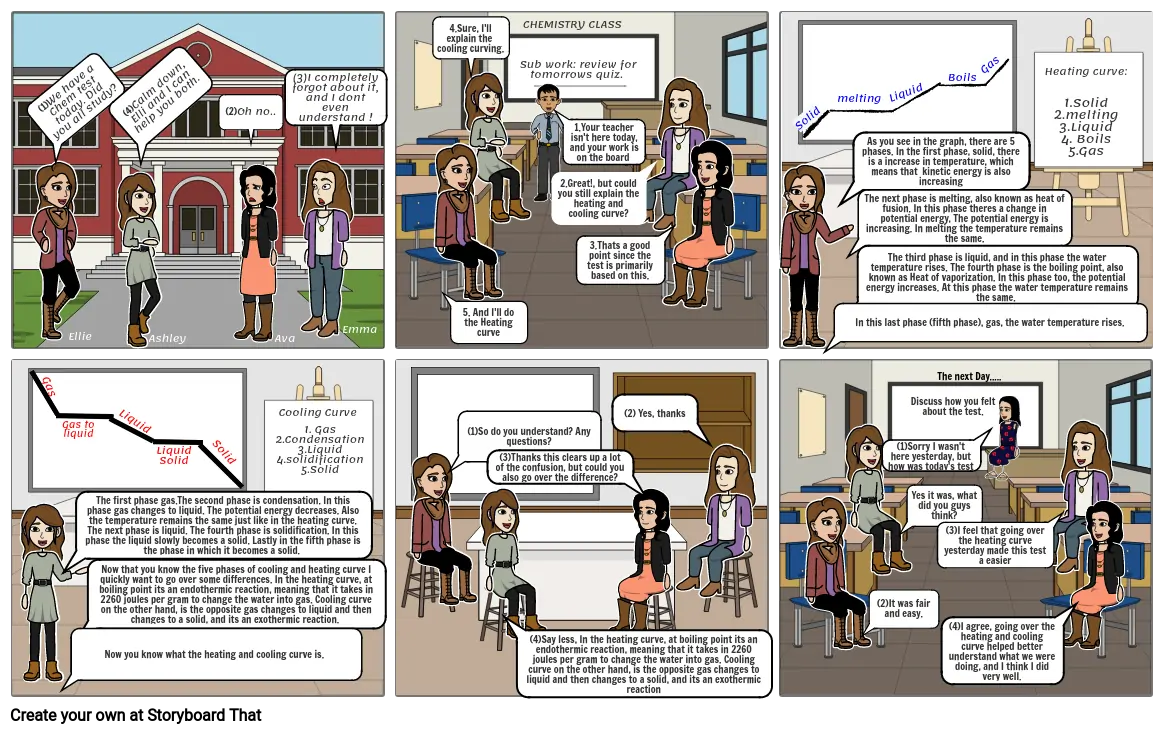Chemistry

Storyboard Text
- (1)We have a Chem test today. Did you all study?
- Ellie
- (4)Calm down, Elli and I can help you both.
- Ashley
- (2)Oh no..
- Ava
- (3)I completely forgot about it, and I dont even understand !
- Emma
- 4.Sure, I'll explain the cooling curving.
- 5. And I'll do the Heating curve
-
- CHEMISTRY CLASS
- Sub work: review for tomorrows quiz.
- 2.Great!, but could you still explain the heating and cooling curve?
- 3.Thats a good point since the test is primarily based on this.
- 1.Your teacher isn't here today, and your work is on the board
- Solid
- melting
- In this last phase (fifth phase), gas, the water temperature rises.
- As you see in the graph, there are 5 phases. In the first phase, solid, there is a increase in temperature, which means that kinetic energy is also increasing
- The third phase is liquid, and in this phase the water temperature rises. The fourth phase is the boiling point, also known as Heat of vaporization. In this phase too, the potential energy increases. At this phase the water temperature remains the same.
- The next phase is melting, also known as heat of fusion. In this phase theres a change in potential energy, The potential energy is increasing. In melting the temperature remains the same.
- Liquid
- Boils
- Gas
- Heating curve:
- 1.Solid 2.melting3.Liquid4. Boils5.Gas
- Gas
- Gas to liquid
- Now you know what the heating and cooling curve is.
- The first phase gas.The second phase is condensation. In this phase gas changes to liquid. The potential energy decreases. Also the temperature remains the same just like in the heating curve. The next phase is liquid. The fourth phase is solidification. In this phase the liquid slowly becomes a solid. Lastly in the fifth phase is the phase in which it becomes a solid.
- Now that you know the five phases of cooling and heating curve I quickly want to go over some differences. In the heating curve, at boiling point its an endothermic reaction, meaning that it takes in 2260 joules per gram to change the water into gas. Cooling curve on the other hand, is the opposite gas changes to liquid and then changes to a solid, and its an exothermic reaction.
- Liquid
- Liquid Solid
- Solid
- 1. Gas2.Condensation3.Liquid4.solidification5.Solid
- Cooling Curve
- (1)So do you understand? Any questions?
- (3)Thanks this clears up a lot of the confusion, but could you also go over the difference?
- (4)Say less, In the heating curve, at boiling point its an endothermic reaction, meaning that it takes in 2260 joules per gram to change the water into gas. Cooling curve on the other hand, is the opposite gas changes to liquid and then changes to a solid, and its an exothermic reaction
- (2) Yes, thanks
- The next Day.....
- (2)It was fair and easy.
- (1)Sorry I wasn't here yesterday, but how was today's test
- Yes it was, what did you guys think?
- Discuss how you felt about the test.
- (3)I feel that going over the heating curve yesterday made this test a easier
- (4)I agree, going over the heating and cooling curve helped better understand what we were doing, and I think I did very well.
Over 30 Million Storyboards Created

